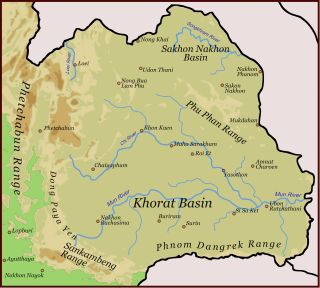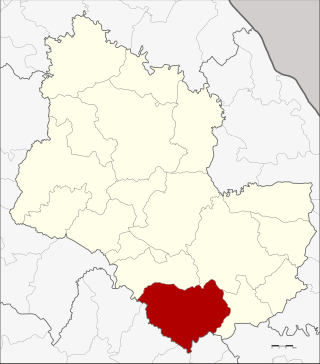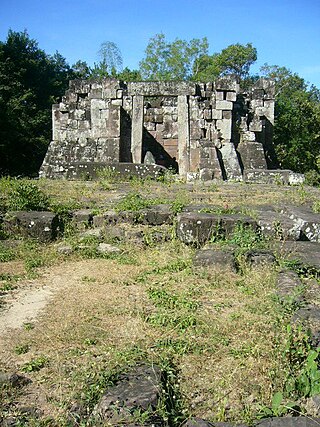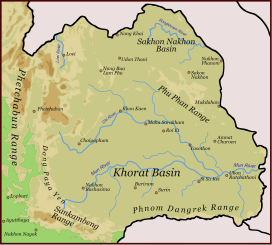
Kalasin is one of Thailand's seventy-six provinces (changwat), located in upper northeastern Thailand, also called Isan. The province was established by the Act Establishing Changwat Kalasin, BE 2490 (1947), and it came into existence on 1 October 1947. Neighboring provinces are Sakon Nakhon, Mukdahan, Roi Et, Maha Sarakham, Khon Kaen, and Udon Thani.

Sakon Nakhon is one of Thailand's seventy-six provinces (changwat). It lies in upper northeastern Thailand and is also called Isan. Neighboring provinces are Nong Khai, Bueng Kan, Nakhon Phanom, Mukdahan, Kalasin, and Udon Thani. Its capital is Sakon Nakhon.

The Phetchabun mountains are a mountain massif in Phetchabun, Phitsanulok, Loei and Chaiyaphum Provinces, Thailand. It consists of two parallel mountain chains, with the valley of the Pa Sak River in the middle.

The Dângrêk Mountains, also the Dângrêk Range, is a mountain range forming a natural border between Cambodia and Thailand. Anlong Veng is the final stronghold of the Khmer Rouge of Democratic Kampuchea and the Maoist dictator Pol Pot which is also the final resting place in his jungle headquarters.

Dong Phaya Yen or Dong Phya Yen is a mountain range in Phetchabun, Chaiyaphum, Lopburi, Saraburi, and Nakhon Ratchasima Provinces, Thailand.

Phu Phan is a district (amphoe) of Sakon Nakhon province, northeast Thailand.

Tao Ngoi is a district (amphoe) of Sakon Nakhon province, northeast Thailand.

Dong Luang is a district (amphoe) of Mukdahan province, northeastern Thailand.

The Sankamphaeng Range, also Sankambeng Range or Sungumpang Range is one of the mountain ranges separating eastern Thailand from the northeast or Isan. It is in Nakhon Nayok, Prachinburi, Sa Kaeo, Saraburi, and Nakhon Ratchasima Provinces, Thailand.

Phra That Phu Pek (Thai:พระธาตุภูเพ็ก) is an ancient temple in Sakon Nakhon Province, in the Isan region of Thailand. This ancient Khmer ruin was built from sandstone, standing on a laterite base. This is a Buddhist temple ruin of Khmer origin in the form of a chedi, it was built in the 16th-17th Buddhist century. The ruin is special as it houses a solar calendar, a cube-shaped rock, in its stupa. The ancients used it for indicating the position of the sun, important for religious rites and agricultural seasons.

The Nakhon Si Thammarat Range is a mountain range on the Malay Peninsula in southern Thailand, running in a north–south direction. This mountain chain is also sometimes named Banthat Range (ทิวเขาบรรทัด), a name which is however also used to refer to the Chanthaburi mountain range.

The Luang Prabang Range, named after Luang Prabang, is a mountain range straddling northwestern Laos and Northern Thailand. Most of the range is located in Sainyabuli Province (Laos), as well as Nan and Uttaradit Provinces (Thailand), with small parts in Phitsanulok and Loei Provinces. Several rivers such as the Nan, Pua and Wa rivers, have their sources in this range. Phu Fa waterfall, the biggest and the tallest waterfall in Nan Province, is also located in these mountains. This range is part of the Luang Prabang montane rain forests ecoregion.

The Phi Pan Nam Range, also Pee Pan Nam, is a 400 km (249 mi) long system of mountain ranges in the eastern half of the Thai highlands. The range lies mostly in Thailand, although a small section in the northeast is within Sainyabuli and Bokeo provinces of Laos.

The Phu Langka Forest Park, or Phu Lang Ka Forest Park, is a protected area of the Phi Pan Nam Range located in Chiang Kham District and Pong District, Phayao Province, Thailand. The park was established on May 8, 2002, and covers an area of 12.48 km2 (4.82 sq mi).

The Phuket Range is a subrange of the Tenasserim Hills in the Kra Isthmus, Thailand.

Phu Phan National Park is a national park in Sakon Nakhon and Kalasin provinces, Thailand. This isolated park covers a wide jungle area in the Phu Phan Mountains of Isan.

Phu Pha Yon National Park is a national park in northeastern Thailand (Isan). Formerly known as Huai Huad National Park (อุทยานแห่งชาติห้วยหวด). The national park covers the area of Mueang Sakon Nakhon, Khok Si Suphan and Tao Ngoi districts of Sakon Nakhon province, Na Kae district of Nakhon Phanom province and Dong Luang, Khamcha-i districts of Mukdahan province.
Ban Kok Kok is a muban (village) in Kok Tum Sub-district, Dong Luang District, Mukdahan Province, Isan region.


















